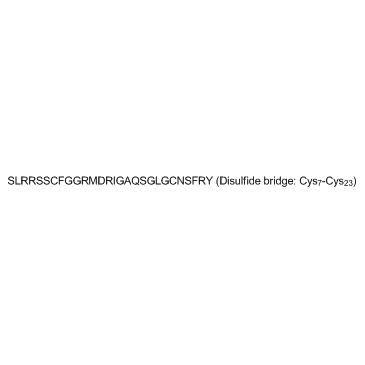Atrial Natriuretic Factor (1-28) (human) acetate salt
Modify Date: 2024-01-09 19:51:40

Atrial Natriuretic Factor (1-28) (human) acetate salt structure
|
Common Name | Atrial Natriuretic Factor (1-28) (human) acetate salt | ||
|---|---|---|---|---|
| CAS Number | 89213-87-6 | Molecular Weight | 3080.444 | |
| Density | 1.6±0.1 g/cm3 | Boiling Point | N/A | |
| Molecular Formula | C127H203N45O39S3 | Melting Point | N/A | |
| MSDS | N/A | Flash Point | N/A | |
Use of Atrial Natriuretic Factor (1-28) (human) acetate saltAtrial Natriuretic Peptide (ANP) (1-28), human, porcine is a 28-amino acid hormone, that is normally produced and secreted by the human heart in response to cardiac injury and mechanical stretch. ANP (1-28) inhibits endothelin-1 secretion in a dose-dependent way. |
| Name | anp 1-28, human |
|---|---|
| Synonym | More Synonyms |
| Description | Atrial Natriuretic Peptide (ANP) (1-28), human, porcine is a 28-amino acid hormone, that is normally produced and secreted by the human heart in response to cardiac injury and mechanical stretch. ANP (1-28) inhibits endothelin-1 secretion in a dose-dependent way. |
|---|---|
| Related Catalog | |
| Target |
Endothelin-1[1] |
| In Vitro | Atrial natriuretic peptide (ANP) is a diuretic, natriuretic, and vasodilatory peptide hormone originally isolated from mammalian hearts. In cultured porcine endothelial cells the inhibition by porcine ANP (1-28) of immunoreactive endothelin-1 secretion after stimulation with Angiotensin II (Ang II) is paralleled by an increase in the cellular cGMP level. Porcine ANP (1-28) strongly inhibits immunoreactive endothelin-1 secretion in porcine aorta after stimulation with Ang II[1]. ANP is a cardiac hormone involved in electrolyte and fluid homeostasis. The inhibition by ANP of endothelin-1 secretion stimulated by angiotensin II (ANGII) and thrombin using cultured human umbilical-vein endothelial cells. Human ANP (1-28) inhibits immunoreactive (ir)-endothelin-1 secretion and increases cyclic GMP in the human umbilical-vein endothelial cells[2]. In glomeruli from normal rats, Human 125I-ANP (1-28) binds to a single population of high affinity receptors with a mean equilibrium dissociation constant of 0.46 nM. Human ANP (1-28) binds to the glomerular ANP receptor with high affinity stimulated cGMP accumulation. Human ANP (1-28) markedly stimulates cGMP generation, but not cAMP generation in normal rat glomeruli[3]. |
| References |
| Density | 1.6±0.1 g/cm3 |
|---|---|
| Molecular Formula | C127H203N45O39S3 |
| Molecular Weight | 3080.444 |
| Exact Mass | 3078.444580 |
| PSA | 1479.28000 |
| LogP | -14.30 |
| Index of Refraction | 1.689 |
CHEMICAL IDENTIFICATION
HEALTH HAZARD DATAACUTE TOXICITY DATA
|
| Atrial natriuretic peptide (human, 1-28) |
| α-Humanatrial natriuretic peptide |
| ANP1-28,HUMAN |
| HSCH2CH2(NHCO)2(CH2)2CH(CH3)2 |
| α-ANF (1-28), human |
| Atrial natriuretic peptide-28 (human) |
| carperitide |
| Pentanamide,N-[[(2-mercaptoethyl)amino]carbonyl]-4-methyl |
| (1-28)-Human atrial natriuretic peptide |
| H-Ser-Leu-Arg-Arg-Ser-Ser-Cys-Phe-Gly-Gly-Arg-Met-Asp-Arg-Ile-Gly-Ala-Gln-Ser-Gly-Leu-Gly-Cys-Asn-Ser-Phe-Arg-Tyr-OH |
| L-seryl-L-leucyl-L-arginyl-L-arginyl-L-seryl-L-seryl-L-cysteinyl-L-phenylalanylglycylglycyl-L-arginyl-L-methionyl-L-aspartyl-L-arginyl-L-isoleucylglycyl-L-alanyl-L-glutaminyl-L-serylglycyl-L-leucylglycyl-L-cysteinyl-L-asparaginyl-L-seryl-L-phenylalanyl-L-arginyl-L-tyrosine cyclic (7->23)-disulfide |
| Atrial Natriuretic Peptide (1-28), human |
| Atrial Natriuretic Peptide (ANP) (1-28), human, porcine |

